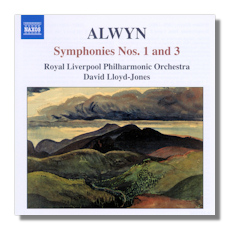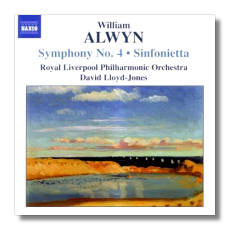
The Internet's Premier Classical Music Source
Related Links
- Alwyn Reviews
- Latest Reviews
- More Reviews
-
By Composer
-
Collections
DVD & Blu-ray
Books
Concert Reviews
Articles/Interviews
Software
Audio
Search Amazon
Recommended Links
Site News
 CD Review
CD Review
William Alwyn

Symphonies
- Symphony #1 (1949)
- Symphony #3 (1955-56)
Royal Liverpool Philharmonic Orchestra/David Lloyd-Jones
Naxos 8.557648


- Symphony #4 (1959)
- Sinfonietta for String Orchestra
Royal Liverpool Philharmonic Orchestra/David Lloyd-Jones
Naxos 8.557649
Alwyn was not your typical classical composer: he wrote nearly 200 film scores, a good many, however, being for short documentary undertakings. He also wrote a number of large scores, including five symphonies, several concertos, and four operas.
The First Symphony (1949) is a generally pleasant, attractive work, which – not to damn it with faint praise – is a nice, though somewhat reticent piece that will have appeal for most listeners with an interest in tonal 20th century symphonies. It is cast in four movements, while the other two symphonies here consist of three each. Alwyn reminds the listener of Vaughan Williams much of the time, more so in the Third and Fourth. He can also call to mind Holst, especially in the Fourth.
The Fourth (1959) is considered Alwyn's best symphony by many of his partisans, but I'll take the craggy, colorful Third (1955-56). It's a sort of tonal twelve-tone work (as the composer, more or less, described it), a bit challenging for the listener, but only in comparison with the more conservative works from the mid-20th century. Those familiar with the Vaughan Williams' Fourth and Sixth Symphonies will find the spirit of those two unsettling works in the Third, but Alwyn is not quite that demonic and dark here. The second movement is utterly haunting in its ethereal main theme and sense of restlessness.
The Fourth is a compelling work, but its big fanfares and other outbursts by brass border on the bombastic at times, at least to my ears. The second movement Scherzo brims with energy and power, giving the listener a truly wild, colorful ride in its outer sections and offering imaginative contrast with a mostly subdued Trio that deftly uses material from the symphony's opening. The filler on the Fourth's disc, Sinfonietta for String Orchestra (1970), is a substantial work based on a motif from Berg's Lulu. Thematically, the work is haunting and many will find it the more appealing piece on the disc.
As I listen further to the works on these two issues I almost want to rank Alwyn at or near the same level as Vaughan Williams. Maybe I'll come to that one day, but for now, I can say Alwyn doesn't quite make it, though he misses out by precious little.
I missed the first issue in this Naxos Alwyn series, which contained the composer's Symphonies #2 and #5, as well as his Harp Concerto, Lyra Angelica. From most commentary I read, it was well-received. For Alwyn aficionados all three recordings will be essential then. David Lloyd-Jones conducts with vigor and insight throughout, and his Royal Liverpool players respond with spirit and a sense for the composer's multi-hued idiom. Naxos provides vivid sound and Andrew Knowles supplies informative notes, which he based partly on writings by Alwyn.
Copyright © 2006, Robert Cummings




















